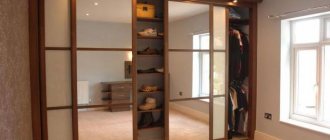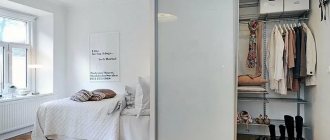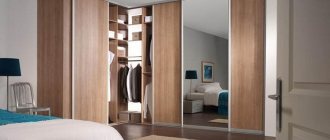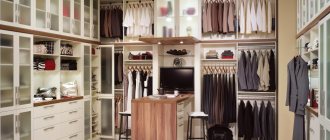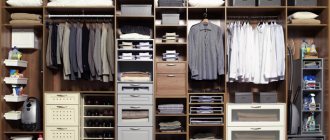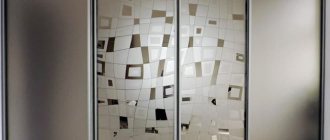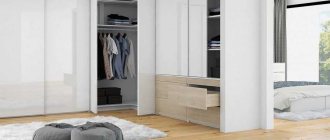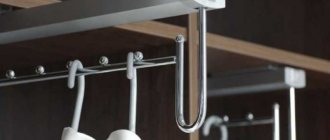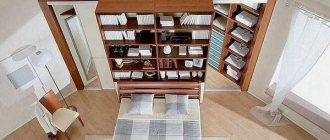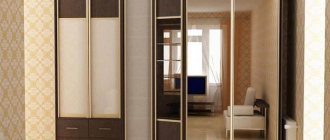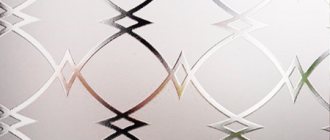Properly designed interior space and skillfully distributed lighting fixtures are half the battle in ensuring excellent functional characteristics of the wardrobe. To make the case as spacious and convenient to use as possible, you need to choose the contents wisely. Sometimes furniture manufacturers, beyond any measure, equip the sections with various mechanisms, which has a negative effect - the cost of the model increases significantly, and the level of comfort, on the contrary, decreases. The Stiver-100 company practices a different method for selecting elements for filling the case, which ensures the best result:
1. During measurements during the process of drawing up the primary project when zoning the building, we comprehensively consider this task and immediately recommend that the client place certain mechanisms in certain departments, justifying our advice.
2. During a conversation with the customer, our employee finds out how many people will use the wardrobe, what things are planned to be stored in it, and whether the client is ready to equip the interior of the cabinet with the most modern and functional devices.
3. Then the cost of the wardrobe is calculated and, based on the results obtained, the project is adjusted - we either add additional elements or remove some mechanisms if the cost of the wardrobe turns out to be too high.
The Stayver-100 company uses fittings made in Western Europe from world-famous brands Vibo, Ambos, Hafele, Kessebohmer and Pelly. By comprehensively operating these mechanisms in the manufacture of custom-made furniture, it is possible to increase the capacity of straight, radius, built-in and corner wardrobes by 20-25%.
Pantographs
A pantograph or furniture lift for clothes is a convenient mechanism that is most often used in the manufacture of sliding wardrobes. This popularity is due to the affordable cost of the device, its versatility and ease of use. One of the main advantages of a pantograph is the ability to easily and simply remove things from the upper compartments of the case. Thanks to the appearance of this wardrobe element, the concept of approach to the formation of the internal space of wardrobes has completely changed.
Those areas that were previously reserved for inconvenient mezzanine compartments with shelves can now be used to store outerwear on hangers. To get the desired item stored on the pantograph bar, you just need to pull the handle towards you - the clothes will smoothly lower on the levers to a level convenient for you, and then the lifting mechanism will smoothly return the bar with the rest of the items to its original position.
In an article devoted to the formation of the internal space of a wardrobe, we paid a lot of attention to the method of “winter-summer” zoning, which involves the use of pantographs. If you want to increase the capacity of your wardrobe and make it more convenient and modern, you should listen to our recommendations and allocate space for installing one or two pantographs in the upper compartments of the case.
On average, these lifting devices can withstand a load of 10 to 15 kg, but this is not the limit. There are pantographs for storing large quantities of outerwear, designed to weigh up to 20 kg. Telescopic rods allow the installation of these lifts in compartments with a width of 450-1150 mm, that is, the dimensions of the pantographs are tied to the most common width of sliding facades. The length of the handle of these mechanisms, regardless of their horizontal dimensions, is 850-910 mm. The minimum permissible height of the compartments in which the pantograph is planned to be installed is on average 900-1000 mm.
All high-quality pantographs that Styver-100 uses in the production of custom-made sliding wardrobes are equipped with power hydraulic mechanisms that provide at least 20 thousand full operating cycles of the device - this is enough for at least 10 years of furniture operation. In addition to pantographs with standard equipment, elite SUPERLIFT models are produced, which have stepwise adjustment of the load capacity and allow you to adjust the angle of inclination. Thanks to this functionality, the operation of lifting mechanisms becomes even more convenient. It is also possible to install pantographs with an electric drive, allowing the rod to move up and down without applying any effort - the movement occurs due to the operation of the electric motor. True, the cost of such devices is several times higher than that of traditional models, and their installation requires changes to the housing design.
The design of pantographs allows you to choose a model that will be combined with the rest of the contents of the wardrobe body. The levers, rod and handle of this lifting mechanism are made of aluminum or steel, with a chrome coating applied to its surface. At the client's request, you can select models with black levers. Hydraulic boxes and pantograph fasteners are usually made of gray or black plastic. Clothes lifts can be fixed both on the side racks of the wardrobe and on its rear wall - there are special fastening plates for this installation method.
The Stayver-100 company equips sliding wardrobes with Hafele, Vibo and Ambos pantographs produced in Germany and Italy. These clothing storage lifts are designed to work reliably and are made from non-toxic materials. The hydraulics of these devices ensure smooth, silent movement of the levers, the absence of significant play during movement and are characterized by increased sensitivity, making Italian mobile gimbals easy to control.
MODUS PROFILE AND GUIDES
A profile for sliding wardrobes is a door frame, including a frame, holders and a sliding opening system. Its main tasks are to support the facade, secure it, ensure fast, unhindered movement of the rollers, and prevent accidental sliding.
For the door system to function properly, you need a combination of several types of guides
There are 6 of them:
1. Vertical profile. Frames the door on the sides and serves to connect it with other elements. Available in different configurations: straight, asymmetrical, S-, L-, H-, U-shaped. It is clearly visible on the façade and is used as a handle.
2. Horizontal bottom bar. It is symmetrical, when cut it has the shape of the letter H. It serves to fix the rollers, covering them.
3. Bottom guide. A profile with tracks for wheels, along which they slide when opening doors.
4. Top bar. It is fixed at the top of the door leaf, connecting it to the rollers. Consists of 1-3 square or rectangular sections.
5. Top guide. Symmetrical deep profile providing space for free movement of wheels.
6. Connecting or intersectional profile. Used in combined decorative facades as a separating element between materials. Available in straight, zigzag, curved and wavy versions. The size of the connecting profile is smaller than the others, since it is installed on one door.
Profile material – aluminum
Aluminum products do not have many disadvantages. These are durable, reliable, flexible guides of different models, dimensions, designs, and purposes. They are resistant to corrosion, moisture, temperatures, and mechanical stress, and therefore last a long time, rarely break, and are easy to repair.
Aluminum slats have thick walls, but they weigh little, making the door easy to open.
Built-in ironing boards for wardrobes
Equipping a wardrobe with a built-in ironing board allows you to save ironing time and space in the room. At first glance, it may seem that its installation will require a lot of space in the case - this is a deep misconception. In addition, storing a traditional ironing board requires a separate space, much more than for a built-in model. And the procedure of removing, laying out and then cleaning the board, without a doubt, got pretty boring for everyone. We offer the best option for placing the ironing iron - to mount it in the body of the wardrobe.
Built-in ironing boards are more stable than their folding prototypes; they unfold quickly and do not block the passage. In addition, when ironing, you can immediately hang and arrange things in the compartments of the wardrobe. Depending on the dimensions of the body and the peculiarities of the formation of the internal space, we offer clients a choice of the following board models:
1. Folding ironing board for installation behind a furniture facade - suitable for sliding wardrobes with a useful cabinet depth of 500 mm. This transformer resembles a regular drawer and does not take up much space - a clearance of 364 mm wide and 140 mm high is enough to accommodate it. The board folds compactly in this small compartment, and when the reliable steel guides are pulled out, it unfolds into a 950 mm long sheet. This telescopic design can withstand a load of 10 kg, which ensures comfortable ironing.
2. Swivel-and-slide transformer - this board is designed for installation in sliding wardrobes with a shallow body. It is perfect for tight spaces without wide aisles, as its transformation mechanism allows for a 180-degree rotation after extension and assembly of the structure. As a result of this layout, the ironing cloth is fixed not perpendicular, but parallel to the front plane of the wardrobe, thereby saving even more space. The rotating and sliding board can be installed in compartments with a depth of 350 mm and a width of at least 520 mm. The clearance height should be 125 mm. Like the previous model, this transformer can withstand a load of 10 kg, and its surface area allows you to iron any thing.
3. Ironing board built into a drawer - this model is a derivative of the first and second transformers. The developers combined the best ideas, resulting in a wide board that, when laid out, does not require much space outside the body. It can be installed either parallel or perpendicular to the front plane of the wardrobe. This design is built into an ordinary box with a bottom made of laminated chipboard 16 mm thick in a compartment with a width and depth of 500 mm. The minimum clearance height is 155 mm.
In addition to these models, there are built-in ironing boards with a solid, non-folding cloth. They have a lower price than the transformers we described, but take up significantly more space in the case. As a result, their installation does not give the expected effect, so we recommend choosing one of three more functional and advanced models.
The Stayver-100 company uses transformable ironing boards from Swedish and German manufacturers Pelly and Hafele for installation. If desired, these models can be supplemented with inserts for smoothing the sleeves. The surface of their canvases is made of heat-resistant plastic and covered with durable cotton fabric. These boards have beveled or rounded edges, allowing you to smooth out hard-to-reach areas of clothing. When designing a wardrobe, our designer-technologist determines the optimal installation height of the transformer, making ironing even more comfortable and quick.
Purpose
Special fittings in the closet are needed so that the doors do not swing open, but move. Moreover, fittings will be required in order to assemble the cabinet body and install sliding doors on it. And finally, a separate category of parts will be needed in order to install the appropriate contents in a straight or corner cabinet.
| Illustrations | Types of fittings and their purpose |
| Guide profiles . These metal guide profiles are installed at the top and bottom of the cabinet, where they are responsible for the movement of the doors in the horizontal plane. In addition, they keep the doors in a vertical position. | |
| Profiles for door assembly . A sliding door consists of a leaf - a rectangular piece of one material or another. The canvas is framed on top, bottom and sides with special profiles. | |
| Rollers . Wheel blocks are installed at the top and bottom of the door. The main load falls on the lower rollers. The structure fixed on top is responsible for positioning the door leaf in the vertical plane. | |
| Stoppers . Stoppers are installed along the edge of the guide profiles, slowing down the movement of the sash as it approaches the cabinet wall. Thanks to the use of stoppers, the cabinet door does not knock, which is important if the facade is glass or mirrored. | |
| Seals . Damping tapes are glued over door profiles and guides, thus dampening noise and vibration. Fuzzy seals prevent dust from penetrating into the cabinet. | |
| Structural fittings . This category includes various hardware that is used to connect body elements, to fasten facades and to install filling elements. |
Sliding system
| Illustrations | Types of sliding systems and their descriptions |
| Supporting . The mechanical load in such systems falls on the lower guide profile, as rollers roll along them. The guides attached to the top of the cabinet perform an auxiliary function. | |
| Hanging . In such designs, the door hangs on the upper rails. There may be no lower profile at all, or it may be attached to orient the sash in a vertical position. |
Which of the two options should I choose? More durable support systems, again, need to be adjusted less often, since their settings are less likely to go astray.
Guides
| Illustrations | Types of guides according to the method of arrangement |
| Upper . These are metal profiles, in the center of which there are grooves with hooks along which the door roller moves freely. | |
| Lower . At the bottom of the opening there is a profile along which the lower rollers move. One track of guides corresponds to the number of sashes. |
Depending on the number of sashes, the guides can be:
Single-lane - it is assumed that one large sash will move horizontally in the closet, opening half of the opening at a time
Two-lane - two or three sashes can be installed on such guides, one of which moves relative to the others.
Three-lane - on such guides you can install a different number of sashes up to 6 or more in some models
Rollers
| Illustrations | Types of roller mechanisms |
| Asymmetry . The roller block is located offset relative to the door. Choosing asymmetrical rollers allows you to move the sash closer to the front edge. | |
| Symmetry . Symmetrical rollers are located flush with the door leaf. Therefore, doors with symmetrical rollers are recessed deep into the cabinet. |
Stopper
| Illustrations | Types of stoppers by location |
| Top-mounted stopper . A rubber stop is installed in the upper profile, which is adjusted towards and away from the side wall. | |
| Bottom-mounted stopper . This element is made in the form of a flexible metal bracket, which is inserted into the groove of the guide profile and absorbs the impact of the door when closing, and then fixes it in the closed position. |
Profiles for door assembly
Metal profiles are attached around the perimeter of the door leaf and provide additional rigidity to the leaf
| Illustrations | Types of profiles used in the assembly of sliding wardrobes |
| Steel . The steel profile is made from a metal sheet with a thickness of 0.3-0.8 mm. The cheaper the fittings, the thinner the metal. The disadvantage of steel profiles is that they bend easily. The advantage of steel products is their reasonable price compared to aluminum counterparts. | |
| Aluminum . The aluminum profile is durable and rigid. Anodized products are characterized by the durability of the coating. The disadvantage of aluminum profiles compared to steel is their higher cost. |
What type of profile should I choose to assemble a sliding wardrobe? The best option is an aluminum frame, since the finished door will be lighter and stronger than a leaf with a steel profile. In addition, the protective coating of anodized aluminum will not peel off for decades, and therefore the cabinet doors will look like new for a long time.
Sealant
In order to eliminate the possibility of dust getting inside the closed cabinet, a seal is installed around the perimeter of the sliding doors
A silicone seal is attached to the sides and bottom of the door, which acts as a damper. Thanks to silicone inserts, the door makes much less noise when sliding. A fleecy seal is attached to the upper part, which does not perform a damping function, but only prevents dust from entering the cabinet.
Filling elements
The simplest content is a shelving unit behind sliding doors, but if you need functional furniture, you can’t do without a lot of useful devices
The ease of use of the cabinet depends on how the contents are selected correctly. The choice of filling is determined taking into account the purpose of the furniture. For example, wardrobes will require one type of hardware, and kitchen cabinets another.
As a rule, there are no problems with the choice of filling, since each manufacturer of furniture fittings has categories selected taking into account the functional purpose.
Filling for the wardrobe
In order for the fittings to bring the desired benefits, you need to calculate their quantity and plan their location at the cabinet design stage
Let us consider, as an example, what is included in the contents of wardrobes with sliding doors.
Inside the wardrobe there are functional fittings with which you can neatly hang things, lay out shoes, compactly place the ironing board and be sure that it will not fall out when opening the doors. The filling of wardrobes can be retractable, folding and static. It is this characteristic that determines the ease of use of the cabinet.
Functional fittings
| Illustrations | Types of functional accessories |
Bar for hangers. This is a metal, or less commonly, wooden crossbar, which is attached to the gap between two vertical walls.
| |
| Retractable hangers . This is a movable alternative to a static rod, which is installed with the transverse end to the front edge of the cabinet. If necessary, the structure extends towards itself and you can hang one or another number of hangers with clothes on it. | |
| Trousers . Trouser hangers are attached to the back wall of the closet, as shown in the photo. There are several types of pants with different holder configurations. It is preferable to use open hangers made in the form of pins - they are easy and convenient to hang trousers on. | |
| Lift for clothes (pantograph). In modern closets, clothes on hangers can be arranged in two tiers. To do this, the bottom row of hangers is located on static rods, and the second level of hangers is placed on a lifting structure - a pantograph. The advantage of using a pantograph is the simple and convenient removal of things from the top row of hangers. | |
| Pull-out baskets and nets for various purposes . Mesh baskets are an alternative to drawers. The advantage of using mesh structures is good all-round ventilation of the contents. As a result, clothes will not develop a musty smell even after prolonged storage. | |
| Shoe rack . There are several types of shoe racks - the photo shows the most common retractable option. The difference between shoe racks and ordinary boxes is that there are special partitions, thanks to which shoes are arranged rationally without taking up much space. | |
| Drawers . This is a standard filling element that is indispensable for storing various small items. In some cases, it is recommended to supplement the drawer with an internal organizer - a lattice with separate cells for each category of clothing. | |
| Handles for cabinet drawers . Since the doors in sliding wardrobes are sliding, special recessed handles are purchased for the drawers that will not touch the doors. | |
| Belt and tie holders . This fittings are in many ways similar to trouser holders, but the holders are smaller in size and have a different configuration. | |
| Holders for iron and vacuum cleaner . Compact wire holders are used to secure household appliances in the cabinet. There are different modifications of holders, but they all have standard sizes, and therefore there will be no difficulties with their choice. | |
| Shelf supports . To install shelves, several types of corners and pins are used, which are fixed to the cabinet walls. The choice of one or another holder depends on the expected load on the shelf. | |
| Furniture legs . When assembling cabinet frame furniture, height-adjustable supports are used. There are plastic models, as shown in the photo, but if the cabinet sections are large, I recommend opting for metal fittings. | |
Closers for sliding systems. Closers make it easier to close the door, and some models allow you to do without a stopper. The door closer is based on a gas lift, as in the design of a transformer wardrobe.
. |
Built-in mirrors for wardrobes
Since not all clients choose mirrored facades for a wardrobe, the issue of arranging a place where you can see yourself in full growth is practically unresolved for many due to a banal lack of space. The Stiver-100 company offers a simple and effective solution to this problem - installing a built-in mirror.
Spanish and Swedish engineers have developed a design for a rotating and sliding mirror that can be mounted into the body of a sliding wardrobe. This design can be mounted on both the right and left side posts in any of the sections. The mirror is mounted in an aluminum profile frame and connected to full extension guides. If necessary, the panel is removed from the body and rotated at any angle convenient for you, firmly locking in a given position.
Retractable mirrors do not take up much space inside the wardrobe and do not interfere with the comfort of using the furniture. For the convenience of customers, manufacturers produce these devices in two sizes - 1155x450 and 565x450 mm. The thickness of the structure is only 38 millimeters. For classic interiors, models with wood-like frames of mirrors are available. The difference in cost between stationary and mobile mirrors is fully compensated by space savings and convenient operation, so we always recommend that customers pay attention to this interesting and useful development.
Features of installation of “pure” hinged sliding doors
Today, in the online trading system and in furniture supermarkets, you can purchase kits for installing sliding doors without a bottom guide. A typical representative is the Raumplus kits.
Preventing vibrations of hanging sliding doors is carried out due to the special design of the upper roller support and the weight of the door leaf. The roller support has a rather complex mechanism. Typically a roller carriage contains four rollers. The advantages of “Raumplus” type structures include ease of installation. The home craftsman should only securely fasten the top profile and install the panels.
However, support-free suspension systems require more careful maintenance and handling. An alternative to these are bottom support wheel designs, which do not require a bottom support rail. In this case, the door leaves have special wheels at the bottom that roll freely directly on the floor surface. As a rule, the lower wheels are spring-loaded, which to a certain extent compensates for uneven floors.
Undoubtedly, the optimal solution for installing sliding interior doors is to contact specialized companies that sell roller kits and install them on a turnkey basis. Most of them offer customers several options when placing an order, differing in both systems and final design. However, many homeowners, after considering various options, opt for self-installation. It is not uncommon for home craftsmen to completely refuse to purchase ready-made kits, purchasing separate panels, separate upper and lower profiles, and ordering roller supports individually.
Pull-out rotating system for sliding wardrobes
For corner wardrobes and models with narrow, deep sections, European hardware manufacturers have created a wonderful design - a rotating and sliding system for storing any items with a supporting steel frame. This device allows you to increase the capacity of the cabinet and ensures the most convenient operation of the wardrobe.
Thanks to its installation, you will not need to sort through clothes on the shelves in the depths of the case in search of the right thing - just pull the frame towards you, and then rotate it around its axis, and any of the compartments of the section will become easily accessible.
Swing-out columns for sliding wardrobes can be installed in sections with a height of 1870-2120 mm and a width of 689-892 mm. In this case, the useful depth of the housing must be at least 550 millimeters. After fixation, the telescopic frame is equipped with hanging mesh baskets and various holders for clothes, including trousers. The complete set of metal elements for storing things is carried out at the request of the client.
Rotating fittings with a supporting frame are an excellent opportunity to carefully systematize the interior space of a dressing room or wardrobe. This device allows you to maintain perfect order and rationally fill the entire body with things from the bottom to the roof, conveniently placing clothes of any shape and size. Styver-100 installs German Kessebohmer swing-and-slide frames with organizational elements that are highly durable and look good inside the cabinet.
Installation
The process of installing sliding doors is simple and consists of assembling all the components, parts and fittings included in the purchased kit. In this case, the apartment owner himself decides whether he will order sliding panels separately or purchase them together with a set. Any person with minimal plumbing skills will be able to perform the installation work independently. However, the assembly process itself requires special care and precision. The first step in installing any horizontally sliding panels is to install and secure the support profiles.
The reliability of the operation of sliding doors and the ease of their operation depend on the qualified and careful installation of the guides. This applies to both top and bottom rail systems and longitudinal opening types. In case of poor installation, the possibility of the sash coming off cannot be ruled out. Of course, such a situation will not lead to tragic consequences, but the work to restore the functionality of the doors is quite labor-intensive.
The simplest option is installation with a single-strip support rail.
This option is used for installing single-leaf interior doors or double-leaf ones, when the leaves are installed without overlap, but end-to-end and slide apart in opposite directions. Let's look at the fastening process using their example.
The assembly of any sliding system begins with fastening the upper support profile. Typically, this operation does not cause problems. For installation, in most cases it is necessary to attach an additional beam to the wall, above the doorway. For a single-leaf door, its minimum length should be equal to double the width of the opening. If double-leaf interior doors are installed in a living space, then the length of the beam should be equal to four times the width of the opening.
After fixing the upper profile, pre-assembled sashes are hung on it. For most industrially manufactured kits, this operation is performed by simply “winding” the door rollers through the end of the support profile.
The hung canvas is aligned vertically, using a level or laser plumb line. Next, you need to secure the bottom guide to the floor. Its installation and fastening depends on the sliding door system (hung or supported), the type of rollers and the nuances of the purchased kit. Usually, at the first stage of installing the lower or fixing profile, it is not rigidly fastened. Having secured it “live”, they check the functionality of the entire structure and only after making sure that the assembly is correct and the panels slide freely, they finally fix it.
Often the fastening of both parts is carried out before installing the rollers on the canvas. The sequence of work is similar to that described above. The alignment of the rail in the vertical plane is controlled using a building level, and the distance between their surfaces is controlled with a regular tape measure. After installing the support profiles, the door leaves are assembled, which are then hung in the usual way.
The video clearly shows the process of installation and installation of sliding wardrobe doors.
Of course, there are other assembly schemes. Some “craftsmen” generally refuse to purchase a full set, purchasing only videos. At the same time, there are more options for creativity, both in the choice of panels themselves and fastening parts.
Pull-out telescopic frames for wardrobes
To equip the interior space of the wardrobe, a useful device has been developed that provides a new higher level of furniture comfort - sliding telescopic frames with steel ball guides. The main advantage of these mechanisms is their independence from the width of the internal opening of the sections. The frames are designed in such a way that they can be expanded to the required width, due to which they are installed in any of the compartments having a clearance in the horizontal plane from 410 to 970 millimeters. Since the range of sizes is quite large, manufacturers produce frames for openings with different widths: • 410-550 mm; • 550-690 mm; • 690-830 mm; • 830-970 mm;
Frames are available for sections with a depth of 360 and 500 mm, which allows you to equip not only standard but narrow sliding wardrobes with these sliding mechanisms. In addition, these devices have another useful quality - they can be equipped with different types of baskets for storing things, making it easier to maintain order at each level in wide sections of the case.
Sliding frames are equipped with high-quality telescopic guides for partial or full extension, which are characterized by silent, smooth running and high reliability. Their frame is made of durable steel wire with a quadruple galvanic or powder metalized coating. The diameter of the wire is designed so that the frame can easily withstand the operating load. In addition to imparting rigidity to the structure of the retractable mechanism, horizontal wire jumpers are designed to fix various baskets, nets, trays and clothes hangers on them.
We use Italian Vibo sliding frames to fill sliding wardrobes. This fittings are not only reliable and convenient, but also look great inside the case, making it stylish and modern. By equipping the lower compartments with such sliding mechanisms, you can independently, using dividing elements, baskets, trays and hangers, shape the interior space of the wardrobe during its operation.
Accessories for sliding wardrobes: classification and purpose
Sliding wardrobes belong to the category of furniture with an ergonomic design. Most often, these structures are made to the full height of the room, thereby increasing the usable area. Inside you can place a large number of clothes, shoes, accessories and small household appliances. The sliding door system for sliding wardrobes allows for more efficient use of space in the room.
All existing types of fittings can be divided into fastening and front
Durability, ease of use, as well as the functionality of the structures depend on what materials the manufacturer uses for sliding wardrobes. The quality and reliability of the fittings are important. This concept implies a whole class of products, each of which has its own role.
Important! All components must correspond to the purpose of the cabinet, otherwise they will not be able to withstand the loads that arise during operation.
Each type of fittings has its own characteristics and design features that allow it to perform certain functions. In wardrobes, components are used for the following purposes:
- full functioning of drawers;
- fixation of the doors, which prevents spontaneous closing of the door;
- convenience when using all elements of internal filling;
- installation of wardrobe doors;
- careful operation of cabinet walls and doors;
- assembly and fastening of all body elements;
- reliable and convenient door opening/closing process.
All types of fittings have their own characteristics and characteristics
Existing types of fittings can be divided into two classes:
- Fasteners.
- Facial.
Facial fittings mainly serve a decorative function. It is used for finishing, although it is not without certain capabilities. The functionality of fasteners is more expanded:
- connection of individual furniture components;
- opening/closing doors;
- raising, lowering and turning furniture elements, etc.
All elements of furniture fittings and components for sliding wardrobes are supplied together with the body part of the structure in disassembled form. Therefore, it is very important to know the purpose of each part, especially if you will assemble the furniture yourself.
Organizational elements for sliding frames
Since the Vibo company has created improved telescopic frames, then, naturally, Italian manufacturers took care of developing a series of organizational elements that allow you to shape the internal space of the departments in a way that is convenient for the furniture owner. To increase capacity and improve the performance characteristics of sliding wardrobes, customers and manufacturers have an impressive arsenal of components:
Hanging nets without edges
Removable lattice sections for linen and various wardrobe items have a height of 87 millimeters and a width of 305; 410; 490 and 730 mm.
Hanging shelf with edge
This organizational element is a lattice box with a height of 86 or 150 millimeters. The frame width of such baskets can be 305; 410; 490 and 730 mm. These lattice boxes are great for storing absolutely any items.
Lattice container for shoes
This element is equipped with two mesh shelves with sides for fixing and is available in two widths - 390 and 470 mm.
Plastic pallet
Container pallets made of translucent CAH plastic have a side height of 86 millimeters and vary in width: 240; 320; 400 and 480 mm. These elements are used to store jewelry, belts and other small accessories.
Metal removable drawers
These containers can replace traditional boxes and are considered more convenient than their original counterparts, as they provide the most convenient access to their contents. These containers have a depth of 86 or 148 mm and are suitable for installation in telescopic frames with an internal opening of 505 mm. The bottom of these elements is made of multilayer material with a wood-like surface.
Wooden divider
It is recommended to organize the internal space of metal containers using beech dividers. This organizational element has a variable number of cells (12 or 15) and is used to store belts, hairpins, cufflinks, cosmetics and other small items.
Laundry basket
It is recommended to place a retractable container for washed clothes under the built-in ironing board - this placement ensures quick and convenient ironing of things. This element is a wooden frame on which a cotton container bag is placed. The laundry basket can be placed on a frame with an internal clearance of 505x480 mm, while the height of the storage container is 430 millimeters.
Trouser holders
Trouser hangers are made of metal or natural wood. These organizational pieces have 7 to 9 runners for hanging pants. Such holders are installed in openings with a depth of 500 mm and a width of 455 or 719 mm.
Sliding plastic tray
It is recommended to install this element on frames on which trouser hangers are placed. The tray has two small bowls 40 mm high, where you can put all small items from your pockets. In addition to all the listed organizational elements for sliding telescopic frames, the Vibo company produces quilted fabric-foam rubber and smooth rubberized mats that help prevent small wardrobe items from falling out of mesh containers.
Sliding system rollers
Another element of the sliding system, on which its quality and service life depends, are the rollers, with the help of which the doors move along the rails and guides. Rollers are available in aluminum, steel, composite and plastic. In addition, they are often made of rubber, equipped with bearings and shock absorbers, which guarantees silent and smooth movement of the doors. Plastic rollers are subject to faster wear, which, of course, will affect the smooth movement of the doors over time.
Combined pull-out hanger
To store items intended for everyday wear, we recommend installing a combined pull-out hanger in one of the compartments of the wardrobe. Thanks to the use of this device, you can save time when getting ready for work and maintain order inside the case. This mechanism is suitable for installation in standard models with a useful section depth of 500 mm. It can be mounted on either the right or left side vertical stand.
The combined pull-out hanger is a two-level design connected to two telescopic ball guides, which are additionally equipped with a soft closing mechanism. The upper tier of the retractable hanger is equipped with a plastic tray for small items and is connected to hangers for suits. This device takes up little space in the compartment, as its width is only 215 mm. Thanks to this compactness, the use of a retractable hanger does not reduce the overall capacity of the wardrobe compartment.
Folding trouser hanger with guides
The side-mounted pull-out trouser rack is suitable for storing men's and women's clothing. It can be installed in a compartment with a depth of side posts of 536 mm, both on the right and on the left. This mechanism, when assembled, protrudes 236 millimeters into the body, taking up relatively little space. The trouser frame has five tubular bars on which clothes can be hung. Like almost all other products in this series, the retractable clothes hanger is made of metal with a galvanic or powder protective and decorative coating and has plastic elements.
This hanger model is a compact mechanism that allows you to save space inside your wardrobe. When disassembled, the frame of this device is in a vertical position, located close to the side post of the section. At the same time, the trousers hung on the jumpers do not wrinkle, although they are located close to each other. When you need to get something out, just lift the frame with the jumpers and place a stop under it, which is movably attached to the frame of the hanger.
Technical features of guides for sliding wardrobe doors and prices for products
Guides for compartment-type cabinets can have several runners. Their number depends on the number of door leaves. The following types of profiles are distinguished:
- single-rail;
- two-way;
- three-row.
For aluminum profiles, two types of coating are used - anodized or colored PVC film
Most models of modern cabinets have a two-way system. The color of the guides depends on the material from which they are made. Steel profiles come in bronze, silver and gold, as well as champagne. If desired, the buyer will be able to select products that imitate various types of wood. The color palette of aluminum profiles is more extensive, as is the choice of textures.
Note! Color coating on steel profiles is less stable and durable. Over time, it becomes covered with cracks and peels off.
There are two types of coatings used on aluminum profiles:
- Anodized coating - chemical methods are used to color the metal surface. The cladding is very durable because the pigment particles penetrate into the material. As a result, the paint is resistant to mechanical stress and is also not afraid of exposure to moisture and direct sunlight.
- Colored PVC film - this type of coating is wear-resistant, durable and moisture-resistant. The film reduces the noise level that occurs during the opening and closing of the doors.
Price table for guides for sliding wardrobes:
| Name | price, rub. |
| Bottom rail, 590 cm (single strip) | 660 |
| Bottom guide, 600 cm (silver) | 660 |
| Bottom guide, 600 cm (bronze) | 1055 |
| Bottom guide, 600 cm (gold) | 1100 |
| Top rail, 590 cm (single strip, silver) | 1200 |
| Top rail, 600 cm (two-way, silver) | 2240 |
| Top rail, 600 cm (two-way, bronze/gold/champagne) | 2420 |
Pull-out nets for storing shoes
Retractable shoe storage stands have sections located at an angle, which are equipped with special anti-slip mats. Thanks to this, all shoes placed on them remain in their place during the opening and closing process of the mechanism. The frame of these devices is made in two versions (2 or 3 inclined shelves) and has a height of 598 or 789 mm, respectively. In addition, retractable shoe racks can be equipped with plastic containers for storing shoe care products.
Retractable shoe nets are designed for installation in wardrobes with compartment depths of 360 and 500 mm. The frame housing of these devices is equipped with ball guides for partial or full extension. Some models are equipped with soft closing mechanisms. The depth of the mesh shelves with a limiting edge allows you to store shoes of any size. The Stiver-100 company recommends allocating lower compartments with a width of about 650 mm for installing retractable shoe racks and installing nets on both the right and left side racks. In this case, all the space available in the compartment will be used with maximum benefit, and you will be able to get rid of empty areas in the wardrobe body.
Installation of ball guides for sliding wardrobe drawers
Modern models of chest of drawers guides have become the optimal replacement for conventional wooden planks, which have been used for quite a long time to move drawers. Telescopic fittings are considered the most practical and functional. It consists of ball guides with the possibility of full extension.
Advantages of full extension ball slides:
- reasonable cost;
- smooth and soft movement;
- excellent strength characteristics;
- wear resistance;
- simple installation system.
Ball guides can support weights up to 25 kg
Telescopic guides are characterized by a hidden type of installation. This type of fittings is used not only in chests of drawers, but also in wardrobes, desks, and kitchen furniture. Don’t forget about the advantages of hidden-mounted guides with a closer. Such models allow you to pull out the drawer to its full length, thereby gaining access to all the things stored in it. The oil closer ensures smooth closing.
The ball guide mechanism with a closer can withstand up to 50 thousand openings and closings. The design of the fittings is designed for weight loads up to 25 kg.
Pull-out laundry baskets with one-sided fastening
To store small wardrobe items and linen, you can use multi-level pull-out mechanisms that are attached to one of the vertical side racks of the wardrobe. These mechanisms are completely identical to retractable shoe nets - both in size, number of levels, and operating principle. The only difference is that the frame of these devices is not equipped with inclined shelves with a side, but with mesh baskets with a depth of 64 millimeters. These devices are characterized by high load capacity and quiet, smooth running.
Boot clips
Pull-out grids with inclined shelves are an excellent place to store shoes, but they can only accommodate shoes, sandals, sneakers and other low-rise models. But for storing boots, we recommend using other fairly simple and effective devices - boot clips, which will allow you to keep your shoes in perfect order and prevent the tops from losing their shape.
Externally, boot clips resemble large plastic clothespins. These devices are screwed to the side racks of the wardrobe and can be installed in any free area, thanks to which you can keep your shoes in perfect order and increase the capacity of the case. The Stiver-100 company prefers compact and durable shoe clips made in Sweden or Italy: Pelly and Ambos. These products are made of non-toxic gray plastic that does not contain chlorine compounds.
Retractable top-mounted hanger
Although top-mounted pull-out hangers are produced in two versions: for sliding wardrobes with a useful cabinet depth of 360 and 500 mm, we recommend using only the first model. In the second case, when the depth of the compartments is 500 mm, there is no need to install this device, since it is more rational to install a stationary oval bar for hangers in a compartment with such dimensions.
A retractable hanger is indispensable in narrow models, the depth of which does not allow hanging clothes in the traditional way. We equip custom-made sliding wardrobes with Italian Vibo mechanisms with reliable full or partial extension guides. In addition, these hangers have a convenient steel grip handle and demarcating balls on the clothes rail, thanks to which each item remains in its place.
Decorative components in sliding wardrobes: types of front fittings
This class of products includes elements that remain visible after the cabinet is assembled. Main types of facial fittings:
Edge fittings perform a decorative function and protect the edges of the cabinet from damage
- Handles for sliding wardrobes - used for opening doors, drawers and sashes. If the wardrobe has pull-out drawers, it is advisable to use mortise handles, which are not only convenient to use, but also will not create obstacles to opening the sliding system. This type of handle can also be used on door leaves. To fix such products, facade milling is used. Handles are available in oval, round and rectangular shapes.
- Edge materials - have a decorative purpose, improve the appearance of furniture, and also protect the edges from mechanical damage.
- Locking mechanisms for sliding wardrobes - used to lock door leaves and built-in drawers.
- Decorative components are elements that are used as decorations, as well as products used to disguise seams and various structural parts. They have the form of overlays, which can be voluminous or flat.
Note! If desired, additional fittings can be added to the standard package during cabinet assembly, if you first provide space for it.
There are several requirements for front fittings. Since these elements are located on the outside of the cabinet and are in plain sight, they must maintain their aesthetics for a long time. In addition, the front fittings should be easy to use. It is advisable to select products with a durable coating that will not be subject to mechanical damage, abrasion and fading.
Handles for sliding wardrobes are oval, round and rectangular
Manufacturers use wood, metal or plastic to make decorative fittings. The type of material is selected taking into account the design of the furniture, as well as the structural features of the cabinet.
Pull-out hangers for tie belts and waistbands
To keep ties and belts in perfect condition and not spend a lot of time searching for the right accessory, you need to find a couple of places in the wardrobe body to install retractable hangers for these wardrobe items. Such “storages” for belts and ties have a common principle of operation with all other retractable mechanisms and can be installed in compartments with a depth of 360 or 500 millimeters.
Conclusion
Upgrading a wardrobe with all the listed mechanisms is not the cheapest pleasure. However, equipping the internal space of the case with only stationary rods, shelves made of chipboard and ordinary drawers is yesterday and bad manners. We will help you choose the most necessary devices that are ideal for your model. Thanks to this selectivity, the cost of the wardrobe will remain at the price level that is accessible to any buyer.
